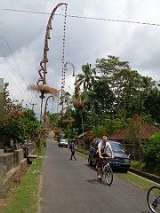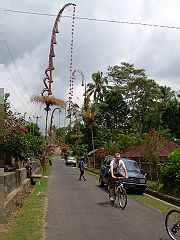
Galungan
Encyclopedia
Galungan is a Balinese
holiday that occurs every 210 days and lasts for 10 days. Kuningan
is the last day of the holiday. Galungan means "When the Dharma is winning." During this holiday the Balinese gods
visit the Earth and leave on Kuningan.
Occurring once in every 210 days in the pawukon
(Balinese cycle of days), Galungan marks the beginning of the most important recurring religious ceremony that is celebrated by all Balinese. During the Galungan period the deified ancestors of the family descend to their former homes. They must be suitably entertained and welcomed, and prayers and offerings must be made for them. Those families who have ancestors that have not yet been cremated, but are still buried in the village cemetery, must make offerings at the graves.
 Although Galungan falls on a Wednesday, most Balinese will begin their Galungan 'holiday' the day before, where the family is seen to be busily preparing offerings and cooking for the next day. While the women of the household have been busy for days before creating beautifully woven 'banten' (offerings made from young coconut fronds), the men of our village usually wake up well before dawn to join with their neighbours to slaughter a pig unlucky enough to be chosen to help celebrate this occasion. Then the finely diced pork is mashed to a pulp with a grinding stone, and moulded onto sate sticks that have been already prepared by whittling small sticks of bamboo. Chickens may also be chosen from the collection of free-range chickens that roam around the house compound. Delicate combinations of various vegetables, herbs and spices are also prepared by the men to make up a selection of 'lawar' dishes. While much of this cooking is for use in the offerings to be made at the family temple, by mid-morning, once all the cooking is done, it is time for the first of a series of satisfying feasts from what has been prepared. While the women continue to be kept busy with the preparations of the many offerings to be made at the family temple on the day of Galungan, the men also have another job to do this day, once the cooking is finished. A long bamboo pole, or 'penjor', is made to decorate the entrance to the family compound. By late Tuesday afternoon all over Bali the visitor can see these decorative poles creating a very festive atmosphere in the street.
Although Galungan falls on a Wednesday, most Balinese will begin their Galungan 'holiday' the day before, where the family is seen to be busily preparing offerings and cooking for the next day. While the women of the household have been busy for days before creating beautifully woven 'banten' (offerings made from young coconut fronds), the men of our village usually wake up well before dawn to join with their neighbours to slaughter a pig unlucky enough to be chosen to help celebrate this occasion. Then the finely diced pork is mashed to a pulp with a grinding stone, and moulded onto sate sticks that have been already prepared by whittling small sticks of bamboo. Chickens may also be chosen from the collection of free-range chickens that roam around the house compound. Delicate combinations of various vegetables, herbs and spices are also prepared by the men to make up a selection of 'lawar' dishes. While much of this cooking is for use in the offerings to be made at the family temple, by mid-morning, once all the cooking is done, it is time for the first of a series of satisfying feasts from what has been prepared. While the women continue to be kept busy with the preparations of the many offerings to be made at the family temple on the day of Galungan, the men also have another job to do this day, once the cooking is finished. A long bamboo pole, or 'penjor', is made to decorate the entrance to the family compound. By late Tuesday afternoon all over Bali the visitor can see these decorative poles creating a very festive atmosphere in the street.
On Wednesday, the day of Galungan, one will find that most Balinese will try to return to their own ancestral home at some stage during the day, even if they work in another part of the island. This is a very special day for families, where offerings are made to God and to the family ancestors who have come back to rest at this time in their family temple. As well as the family temple, visits are made to the village temple with offerings as well, and to the homes of other families who may have helped the family in some way over the past six months.
The day after Galungan is a time for a holiday, visiting friends, maybe taking the opportunity to head for the mountains for a picnic. Everyone is still seen to be in their 'Sunday best' as they take to the streets to enjoy the festive spirit that Galungan brings to Bali.
The date for Galungan and other special Balinese days is shown on the Balinese Calendar. Galungan is also celebrated in the rest of Indonesia such as in the Balinese communities spread over Sumatra.
Balinese people
The Balinese population of 3.0 million live mostly on the island of Bali, making up 89% of the island's population. There are also significant populations on the island of Lombok, and in the eastern-most regions of Java The Balinese population of 3.0 million (1.5% of Indonesia's population) live...
holiday that occurs every 210 days and lasts for 10 days. Kuningan
Kuningan
Kuningan is a city in eastern West Java, Indonesia, between Cirebon and Tasikmalaya, about 200 km east of Jakarta. The area is near Mount Cereme/Ciremai , the highest mountain in West Java. The mountain is located in the western part of the region. The eastern part is a valley...
is the last day of the holiday. Galungan means "When the Dharma is winning." During this holiday the Balinese gods
Balinese mythology
Balinese mythology is the traditional mythology of the people of the Indonesian island of Bali, before the majority adoption of Hinduism.Balinese mythology is mainly a kind of animism with some widely-known characters and deities...
visit the Earth and leave on Kuningan.
Occurring once in every 210 days in the pawukon
Pawukon
The Pawukon is a 210 day calendar that has its origins in the Hindu religion in Bali, Indonesia. The calendar consists of 10 different concurrent weeks of 1, 2, 3, 4, 5, 6, 7, 8, 9, and 10 days. On the first day of the year it is the first day of all the ten weeks...
(Balinese cycle of days), Galungan marks the beginning of the most important recurring religious ceremony that is celebrated by all Balinese. During the Galungan period the deified ancestors of the family descend to their former homes. They must be suitably entertained and welcomed, and prayers and offerings must be made for them. Those families who have ancestors that have not yet been cremated, but are still buried in the village cemetery, must make offerings at the graves.

On Wednesday, the day of Galungan, one will find that most Balinese will try to return to their own ancestral home at some stage during the day, even if they work in another part of the island. This is a very special day for families, where offerings are made to God and to the family ancestors who have come back to rest at this time in their family temple. As well as the family temple, visits are made to the village temple with offerings as well, and to the homes of other families who may have helped the family in some way over the past six months.
The day after Galungan is a time for a holiday, visiting friends, maybe taking the opportunity to head for the mountains for a picnic. Everyone is still seen to be in their 'Sunday best' as they take to the streets to enjoy the festive spirit that Galungan brings to Bali.
The date for Galungan and other special Balinese days is shown on the Balinese Calendar. Galungan is also celebrated in the rest of Indonesia such as in the Balinese communities spread over Sumatra.
External links
- Video documenting Galungan ceremony preparations on Bali part 1, part2
- Photos of Bali while Galungan

